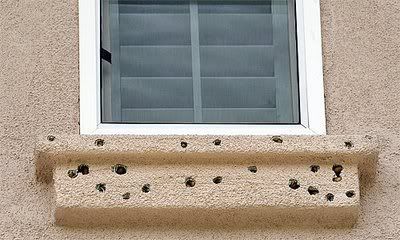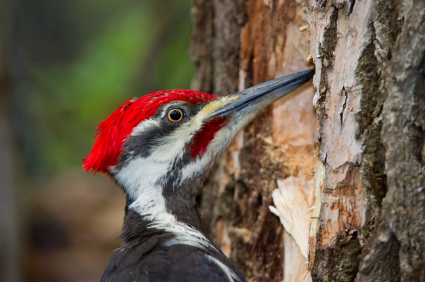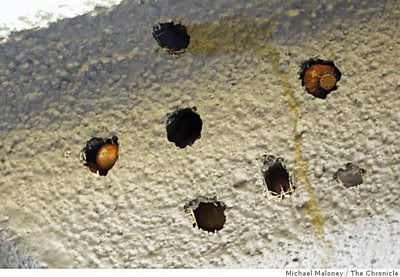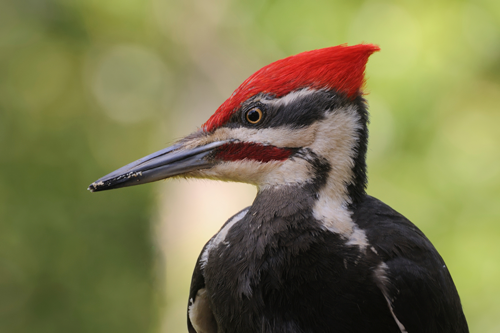by Alex A. Kecskes
It's that time of year again. When
woodpeckers come a knocking and holes start appearing all around your home, patio, gazebo and even your wooden hot tub.
You can't really blame them. They have their reasons for turning your property into "Swiss cheese." One big reason: they're just looking for a meal. They also tap away during their mating season. Woodpeckers love to tap-tap endlessly on aluminum siding and fascia or trim boards on wood, stucco or brick. And this includes metal gutters, downspouts, chimney tops and roof vents. Time to bird proof your property.
Woodpecker roosting or nesting holes are often found in structures near wooded areas, in clapboard, board-and batten or tongue-and-groove siding made of redwood or cedar. Regrettably, woodpeckers prefer to drill holes in the seams of siding, since there's very little resistance at that juncture. It doesn't matter if the seams are vertical or horizontal, the holes will usually be quite large--baseball size on average. These holes are most often created in the late summer and fall as the birds prepare for winter. Nesting holes, on the other hand, are usually drilled out at the start of the breeding season--between late April and May.
Woodpeckers Destroy Poles, Big TimeTens of thousands of power and telephone poles are destroyed annually by woodpeckers. And they are the primary cause of above-ground wood pole damage. While hundreds of different chemicals have been tried to
deter woodpeckers from wood poles, none have proven effective as a
woodpecker-control measure. Of the wood pole structures damaged by woodpeckers, the larger and more expensive high-tension electric transmission line structures are particularly vulnerable.
Nearly a Dozen Species of WoodpeckersMost people don't realize that there are 22 species of woodpeckers in North America. The most common species in the U.S. is the Downey Woodpecker. Other common species include the Hairy Woodpecker, Pileated Woodpecker and the Northern Flicker.
Woodpeckers usually inhabit woods and forests, but in the absence of bird proofing measures, they will wander into populated areas looking for insects, fruit, acorns and nuts. They tap or peck on tree trunks, poles and wood siding to find insects, to excavate nesting cavities, and to communicate with other woodpeckers. The birds are protected under the Federal Migratory Bird Treaty Act, so forget about shotguns, BB guns, poisons or lethal traps. Any bird control measure used to deter or repel them must be non-lethal and humane.
While there are many species of woodpeckers that can damage your property and your sanity, there are also a number of humane and highly effective bird deterrents you can use to keep them away. And with woodpecker season well upon us, now's the time to arm yourself against their onslaught.
Sounds that Scare WoodpeckersOne of the most effective
woodpecker proofing measures used against woodpeckers is the Sonic Bird Deterrent. These systems have been carefully designed to emit sounds that work on a bird's psyche. In fact, one manufacturer worked with ornithologists at a major university to develop just the right sounds to deter pest birds. A popular sonic system is one that plays the distress calls of over 22 different species of birds. This versatile system can be specifically programmed for woodpeckers to emit hawk sounds, a woodpecker's natural enemy. These threatening sounds can be broadcast every ten minutes to scare woodpeckers from large open spaces.
Some sonic bird deterrent systems have a built-in speaker that will cover up to an acre. Extra speakers can be attached to expand the coverage up to six acres. One advantage sonic systems have against those that emit high-pitched ultrasonic noises is that they don't bother pets. They are an ideal bird proofing measure for deterring woodpeckers from backyards, courtyards, loading docks, warehouses, gardens, patios, parks, golf courses and wooden utility poles.
Devices that Scare WoodpeckersAnother effective
woodpecker control measure, the Bird Scare Device, is an ideal way to bird proof a number of areas from woodpeckers.
Perhaps the simplest of these is Flash Tape. This basic
woodpecker deterrent is often made of iridescent material that shimmers and reflects in the sunlight. This thin metal tape will crackle in the breeze. The combination of audio-visual distractions works to disorient and confuse most species of woodpeckers. Flash tape is easily mounted almost anywhere. It can deter woodpeckers from barns, sheds, storage areas, warehouses, farms, carports parking lots, homes, boats and boat docks.
Another bird scare device that has met with considerable success in deterring woodpeckers is the Bird Scare Balloon. Often covered with huge reflective predator eyes or other bird-threatening markings, these balloons wave in the breeze and convince woodpeckers that danger is about to pounce on them. Most bird scare balloons are about 16” diameter when fully inflated. The best balloons are constructed of a U.V.- resistant and weather-resistant vinyl. They have proven themselves in deterring pest birds from fruit trees, gazebos, boats, patio covers, and building overhangs.
Working on the same basic principle as the bird scare balloon is the Bird Scare Diverter. The pendant-like fixture is typically covered with a large mock eye to make woodpeckers feel really uneasy. These devices work best when hung as close as possible to the area plagued by woodpeckers. Diverters are easy to use, and can be easily stored away when not needed.
One Final ThoughtIf woodpeckers attack your siding or roof, you have one of three food sources they like to feast on:
Female carpenter bees--these drill small round holes about the size of a dime into many different types of wood, including siding and roofing. If these bees have burrowed a three-foot long tunnel, a woodpecker will drill your siding for the full length of the tunnel.
Leafcutter bees--these insects love to nest in the gaps of your horizontal wood siding. They also like cedar shake roofs with their vertical cracks. Woodpeckers often make small horizontal or vertical rows of holes as they search for these little bugs.
Bagworm larvae--these resemble tiny caterpillars attached to tree trunks, wood fencing, or siding. Woodpeckers will go after these larvae and do damage in the process.
Getting rid of these insects can make your property less attractive to woodpeckers.






